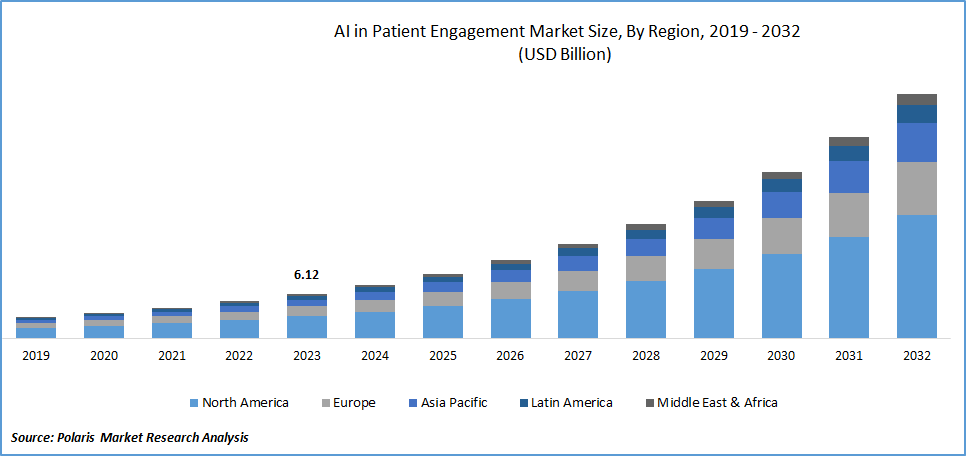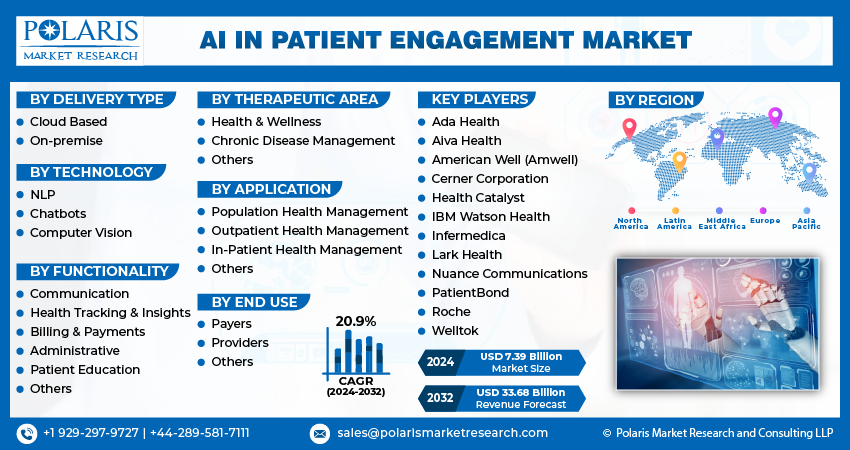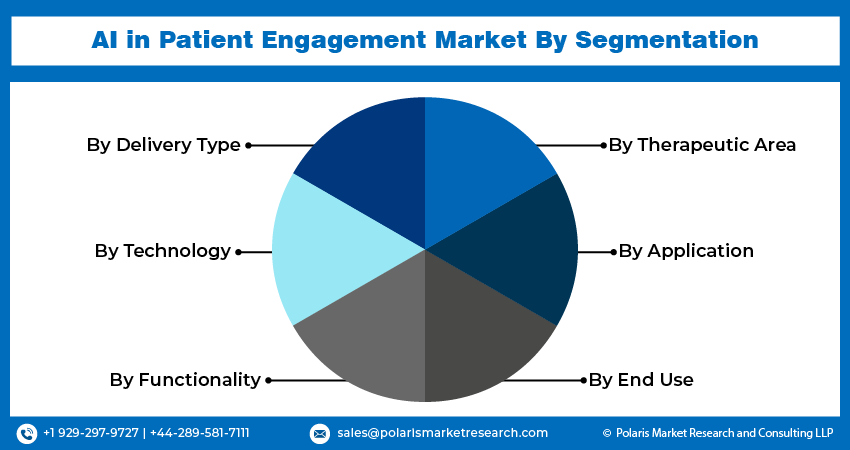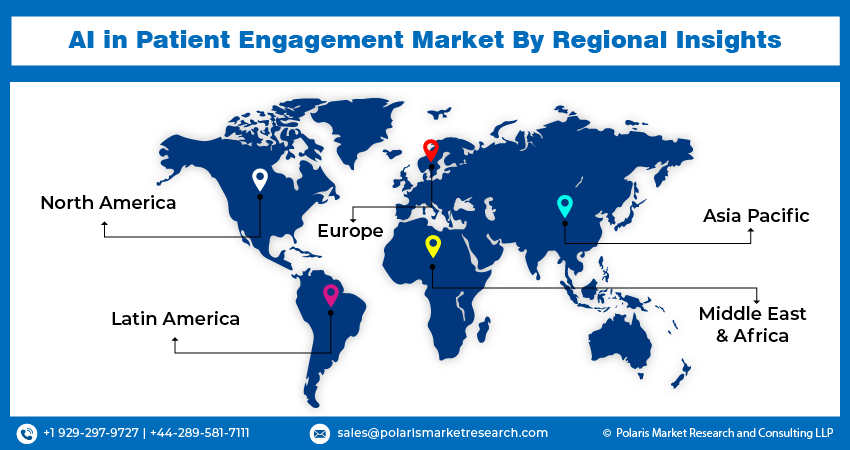
AI in Patient Engagement Market Share, Size, Trends, Industry Analysis Report
By Technology (NLP, Chatbots); By Delivery Type; By Functionality; By Therapeutic Area; By Application; By End-use; By Region; And Segment Forecasts, 2024 - 2032
- Published Date:Feb-2024
- Pages: 118
- Format: PDF
- Report ID: PM4352
- Base Year: 2023
- Historical Data: 2019-2022
Report Outlook
The global AI in patient engagement market was valued at USD 6.12 billion in 2023 and is expected to grow at a CAGR of 20.9% during the forecast period.
Key factors influencing the market growth include increasing demand for personalized healthcare experiences and treatment plans. This demand is fueled by the necessity to customize patient interactions based on individual data and preferences. Additionally, the widespread availability of healthcare data plays a crucial role in boosting the adoption of artificial intelligence (AI) for data analytics. AI technologies enable the prediction of health outcomes and identification of high-risk patients and provide actionable insights. These capabilities enhance patient engagement and improve overall care management.
The appeal of AI in healthcare stems from technological progress and the urgent need to control escalating healthcare expenses. AI offers healthcare providers a way to automate processes, enhancing operational efficiency. The shift toward patient-centered care emphasizes the importance of improved communication, an area where AI can bridge the gap between providers and patients. The ongoing digital transformation in healthcare, hastened by the pandemic, highlights AI's role in enhancing virtual care quality and patient experiences.
Product innovations, technological advancements, and the introduction of regulatory policies have been detailed in the report to enable businesses to make more informed decisions. Furthermore, the impact of the COVID-19 pandemic on the AI in patient engagement market demand has been examined in the study. The report is a must-read for anyone looking to develop effective strategies and stay ahead of the curve.

To Understand More About this Research: Request a Free Sample Report
Furthermore, AI's capabilities in personalized medicine, predictive analytics, and patient empowerment are significant drivers for its adoption. Regulatory backing, increased data accessibility, and the pursuit of a competitive edge further boost AI integration. This integration is supported by substantial investments in research and development, underscoring AI's vital role in the healthcare sector.
AI solutions were employed to enhance data security measures, ensuring the safeguarding of patient data during remote interactions. Regulatory agencies implemented temporary changes to facilitate the use of telehealth and digital health solutions, actively promoting the adoption of AI in patient engagement market. Some regulatory modifications, such as the Centers for Medicare & Medicaid Services expanding reimbursed telehealth services in the 2021 physician fee schedule, became permanent, indicating a lasting shift toward telehealth adoption.

Growth Drivers
Revolutionizing patient engagement and remote monitoring in healthcare
The demand for AI-driven patient engagement solutions has surged alongside the introduction of innovative healthcare approaches, particularly in virtual care. The pandemic played a pivotal role in accelerating the adoption of remote patient monitoring devices, where AI became essential in interpreting patient data collected outside traditional clinical environments. AI-powered analytics empowered healthcare providers to remotely monitor and manage patient health, reducing the risk of COVID-19 exposure. This approach encouraged patients to participate in their self-care actively. Additionally, AI-driven chatbots and virtual therapists played a vital role in disseminating accurate and up-to-date COVID-19 information. They alleviated the strain on healthcare communication channels and ensured patients had reliable access to essential information.
Report Segmentation
The market is primarily segmented based on delivery type, technology, functionality, therapeutic area, application, end use, and region.
|
By Delivery Type |
By Technology |
By Functionality |
By Therapeutic Area |
By Application |
By End Use |
By Region |
|
|
|
|
|
|
|
To Understand the Scope of this Report: Speak to Analyst
By Delivery Type Analysis
Cloud based segment held the largest share of the market in 2023
The cloud based segment held the largest share and is expected to grow at a substantial CAGR. The popularity of cloud-based delivery can be credited to its scalability, remote accessibility, and flexibility, making it the preferred choice for healthcare providers looking for cost-effective and adaptable solutions. Cloud platforms enable smooth integration of data from diverse sources, ensuring the analysis of patient data for personalized engagement, further enhancing their appeal in the healthcare sector.
Cloud-based solutions provide regular updates, strong data security protocols, and compliance certifications, easing maintenance tasks and addressing privacy worries. These solutions encourage collaboration, connectivity, and efficient communication among healthcare practitioners and patients. They utilize advanced machine learning and AI capabilities for data-driven insights. Additionally, their predictable cost models and disaster recovery strategies make them popular among healthcare institutions aiming to enhance patient engagement and streamline operations.
Utilizing artificial intelligence enables healthcare providers to streamline administrative tasks, tailor patient interactions, and enhance overall practice efficiency. These innovations foster a patient-centered healthcare environment, improving communication, accessibility, and the overall quality of care. These solutions play a crucial role in elevating the patient experience through effective communication platforms, remote monitoring features, and insights derived from data analysis.
By Technology Analysis
Chatbots segment accounted for the largest market share in 2023
The Chatbot segment accounted for the largest market share and will grow at a substantial pace. Chatbots have emerged as a dominant force in the market, revolutionizing healthcare by offering real-time automated patient interactions. Their round-the-clock availability, instant responses, and capacity to handle various tasks, from scheduling appointments to disseminating health information, have made them the preferred choice for healthcare providers seeking to enhance patient engagement, streamline processes, and elevate overall healthcare experiences. AI-driven chatbots in patient engagement have the potential to transform healthcare significantly, promising improved patient outcomes and reduced costs.
By Therapeutic Area Analysis
Chronic disease management segment held the largest revenue share of the market
The chronic disease management segment held a significant market share. Segment’s share is primarily due to the rising elderly population in key markets, the growing prevalence of chronic health conditions, and the swift adoption of digital technologies due to the influence of the COVID-19 pandemic. Patient engagement solutions, especially those powered by AI, play a crucial role in tackling chronic diseases. They assist in the prevention, early detection, and continuous management of these conditions, highlighting their vital role in healthcare.
The health & wellness segment will grow at the fastest pace. AI-driven patient engagement solutions play a vital role in advancing health and wellness. They contribute significantly to the prevention and early detection of health issues and support individuals in managing their well-being. This assistance can occur either through collaboration with healthcare providers or through self-care practices, highlighting their essential role in promoting overall health and wellness.
By End Use Analysis
Providers segment accounted for the largest market share in 2023
The provider's segment accounted for the largest market share. Healthcare providers handle a vast number of patients and act as the first point of contact for a diverse array of health concerns, ranging from general inquiries to specialized consultations. As a result, they constitute the largest user group embracing patient engagement solutions.
Payer’s segment will grow at the fastest pace. This growth is attributed to the increasing adoption of solutions designed to engage patients and customers. These solutions enable extensive coverage and promote the delivery of value-based healthcare services. To enhance this expansion, payers are developing strategies to oversee patient care and establish continuous connections with patients throughout every stage of their treatment journey.

Regional Insights
North American region accounted for the largest share of the market in 2023
North America dominated the market. This was due to the active participation of key industry players, the growing use of mobile health (mHealth) & electronic health record (EHR) systems, and significant investments made by leading companies in patient engagement software. Additionally, high awareness levels among stakeholders and increased government spending in the healthcare sector are expected to accelerate this growth further.
Asia Pacific will grow at the fastest pace. The region’s growth is primarily due to the widespread use of the internet and smartphones, a large patient population, continuous improvements in healthcare infrastructure and services, and the active involvement of local industry players. Moreover, the economic advancements in emerging nations are notably enhancing the region's overall growth potential. These combined elements establish a conducive atmosphere for strong market expansion in the years ahead.

Key Market Players & Competitive Insights
Startups are bringing forward creative concepts and solutions that harness AI to address diverse patient engagement challenges, spanning from enhancing medication adherence to improving telehealth experiences. Concurrently, major technology corporations are extending their footprint in the healthcare industry by creating AI-driven healthcare platforms and services.
Some of the major players operating in the global market include:
- Ada Health
- Aiva Health
- American Well (Amwell)
- Cerner Corporation
- Health Catalyst
- IBM Watson Health
- Infermedica
- Lark Health
- Nuance Communications
- PatientBond
- Roche
- Welltok
Recent Developments
- In October 2023, CipherHealth announced the development of an AI solution for patient communication using Google Cloud's Vertex AI platform. These AI solutions strive to significantly speed up problem-solving, enhance patient experiences, automate processes, and facilitate two-way communication effectively.
- In September 2023, Belong Life introduced Tara. It aims to expedite the patient matching process for eligible clinical trials, leading to higher recruitment rates at substantially reduced costs.
- In April 2023, Notable introduced Patient AI. This innovative technology continuously assesses a wide range of data points from medical records and external sources. This process enables the creation of a thorough understanding of each patient's clinical and social background.
- In August 2023, ZextGen Healthcare introduced NextGen Luma. This innovative platform is crafted to elevate patient interactions and experiences by providing a smooth and user-friendly interface.
AI in Patient Engagement Market Report Scope
|
Report Attributes |
Details |
|
Market size value in 2024 |
USD 7.39 billion |
|
Revenue forecast in 2032 |
USD 33.68 billion |
|
CAGR |
20.9% from 2024 – 2032 |
|
Base year |
2023 |
|
Historical data |
2019 – 2022 |
|
Forecast period |
2024 – 2032 |
|
Quantitative units |
Revenue in USD billion and CAGR from 2024 to 2032 |
|
Segments covered |
By Delivery Type, By Technology, By Functionality, By Therapeutic Area, By Application, By End-Use, By Region |
|
Regional scope |
North America, Europe, Asia Pacific, Latin America, Middle East & Africa |
|
Customization |
Report customization as per your requirements with respect to countries, region and segmentation. |
We strive to offer our clients the finest in market research with the most reliable and accurate research findings. We use industry-standard methodologies to offer a comprehensive and authentic analysis of the AI in patient engagement market. Besides, we have stringent data-quality checks in place to enable data-driven decision-making for you.
FAQ's
Cerner Corp., IBM Watson Health, Nuance Communications, Ada Health, Lark Health, Welltok, Aiva Health are the key companies in AI in Patient Engagement Market.
The global AI in patient engagement market is expected to grow at a CAGR of 20.9% during the forecast period.
The AI in Patient Engagement Market report covering key segments are delivery type, technology, functionality, therapeutic area, application, end use, and region.
Expanding integration of virtual health technologies are the key driving factors in AI in Patient Engagement Market.
The global AI in patient engagement market size is expected to reach USD 33.68 billion by 2032
